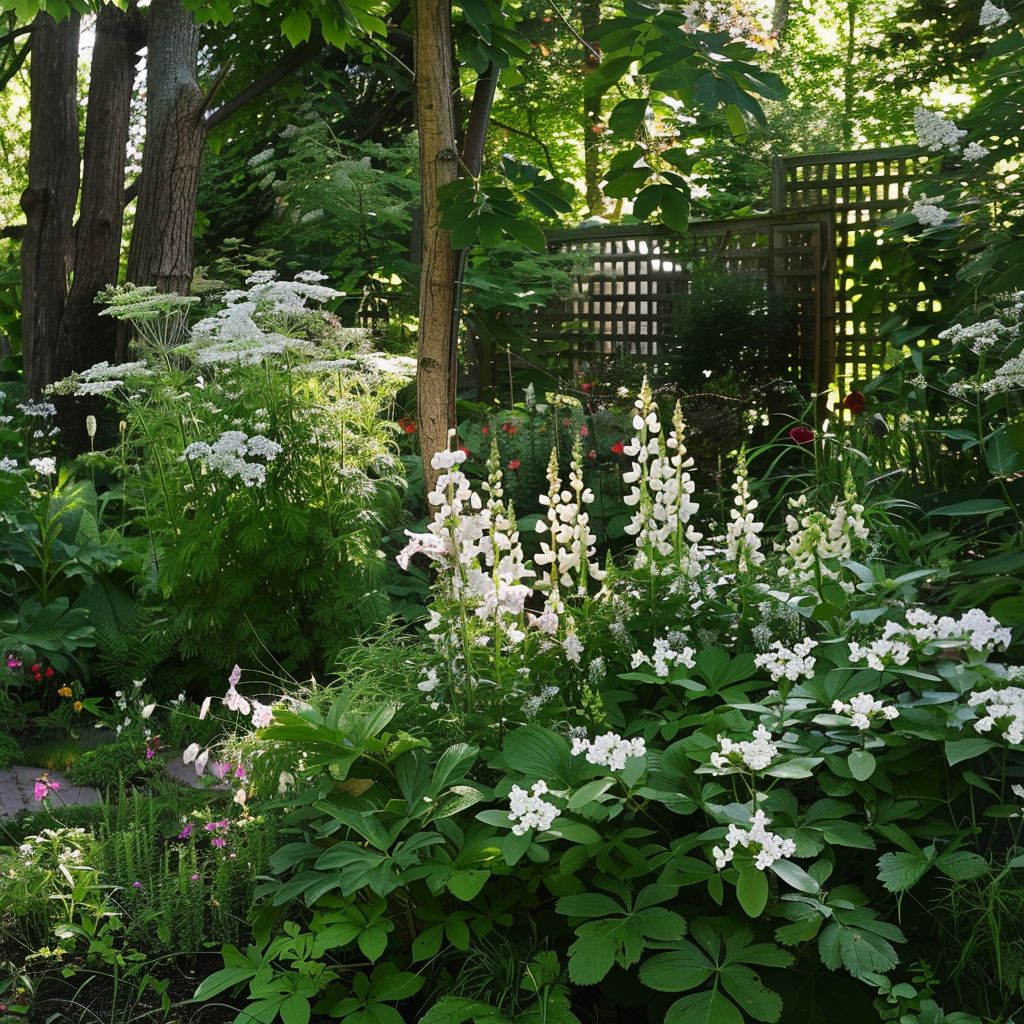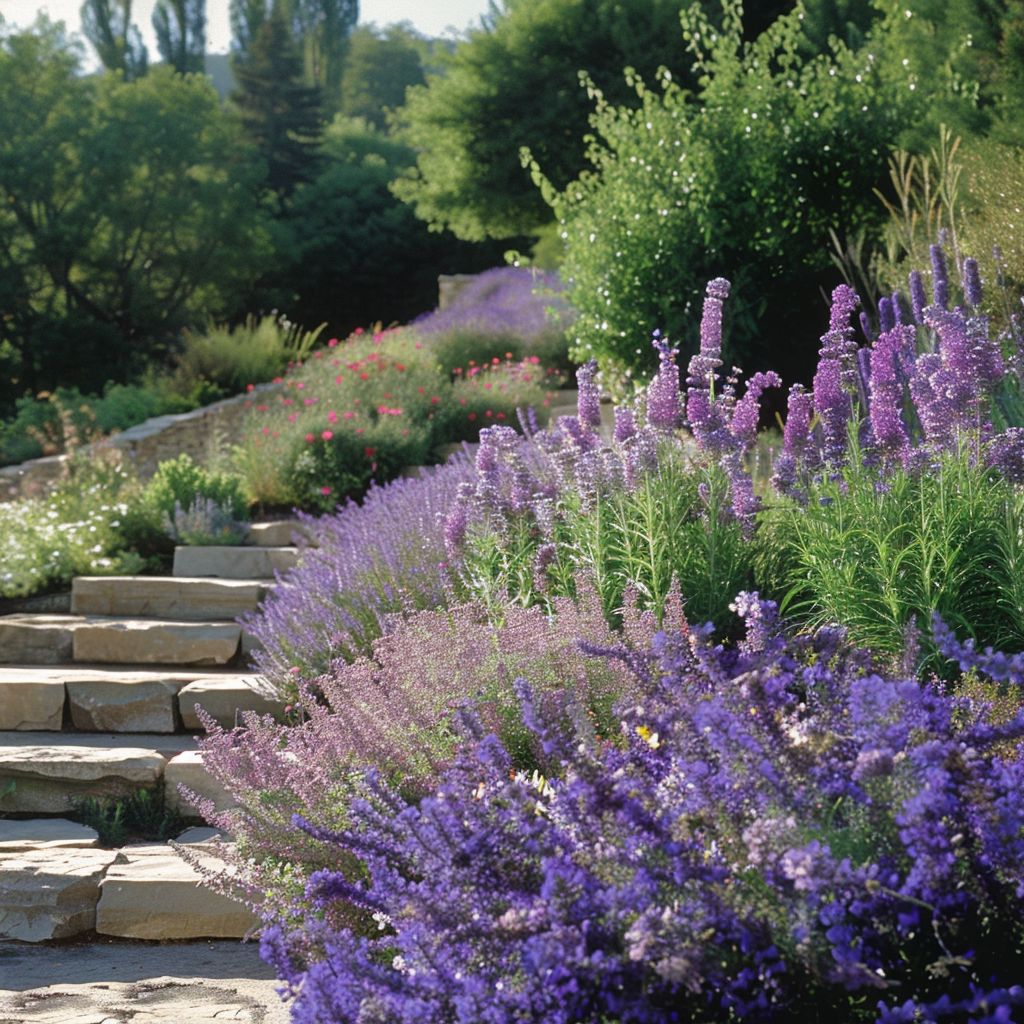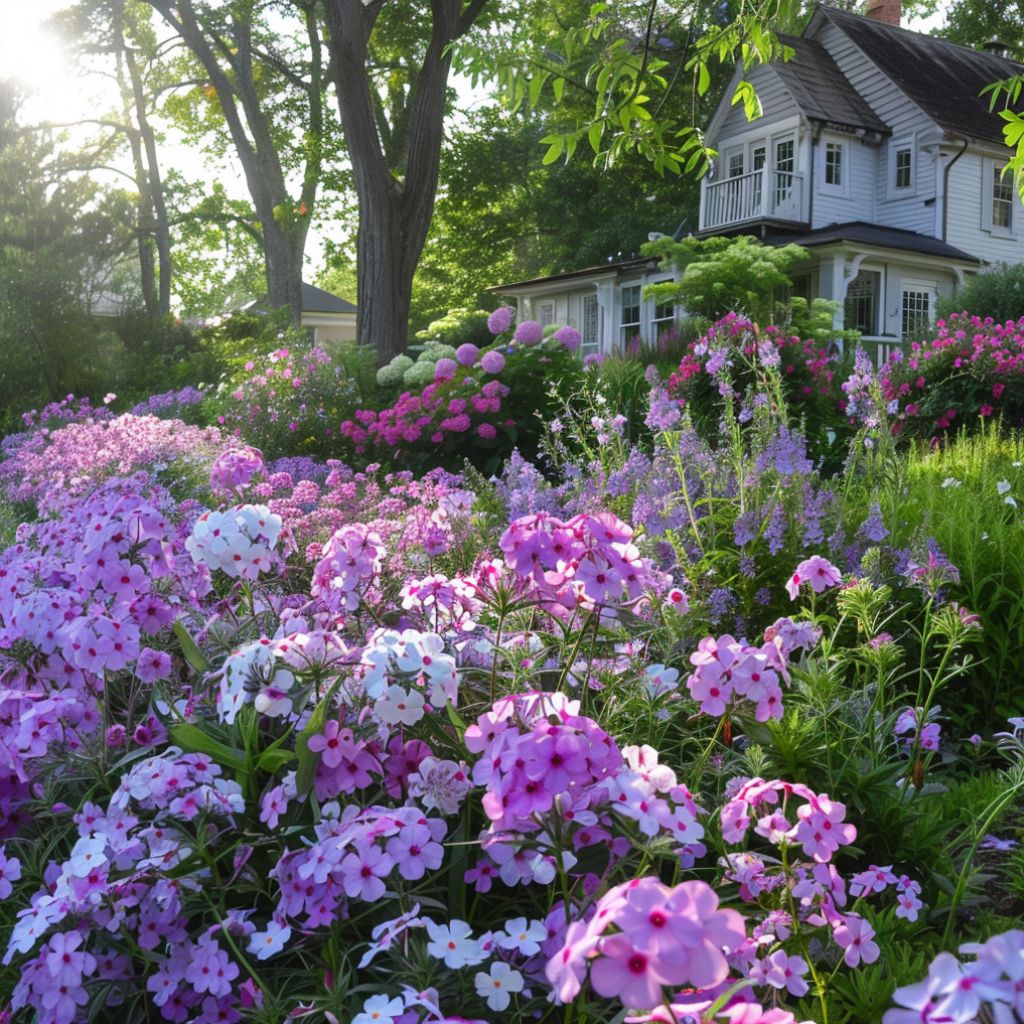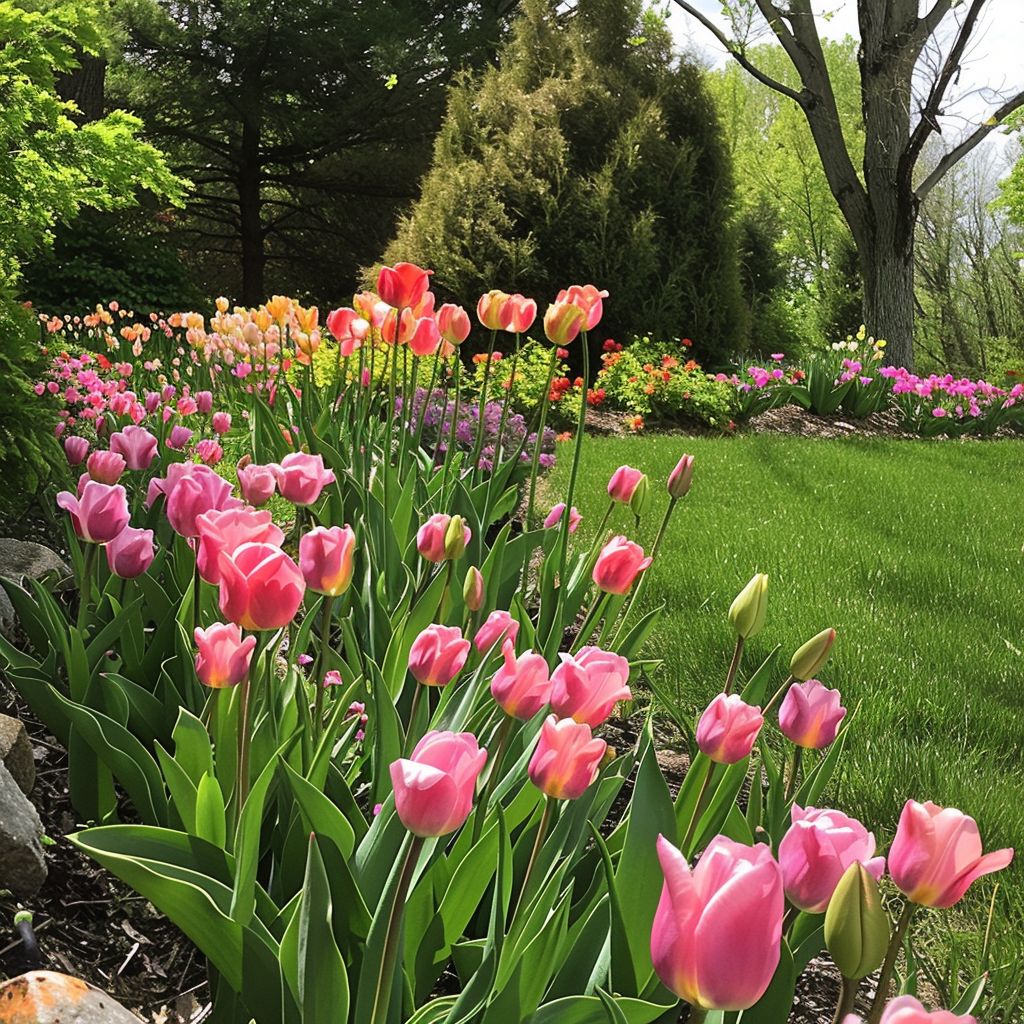Creating a perennial garden that bursts with colour and interest year-round can be quite the challenge. You may well find yourself constantly moving and dividing plants, paying close attention to bloom times, and experimenting with different combinations each season. It’s no wonder many gardeners feel overwhelmed by the complexity of designing a stunning perennial garden.
But don’t let that deter you. With a thoughtful approach and some expert tips, you can transform your landscape into a vibrant tapestry of continuous colour, intriguing textures, and harmonious design. Imagine looking out your window or sitting in your yard, surrounded by a garden that not only brings you joy but also impresses every passer-by.
Let’s explore how you can achieve this perfect balance in your own perennial garden design.
Types of Perennial Gardens
Perennial gardens offer various styles to fit different climates, soil types, and personal preferences. Below are some popular garden types.
Water-Wise Garden
A water-wise garden prioritises drought-tolerant plants and efficient watering systems. This style suits areas with low rainfall or water restrictions. Common plants include succulents, cacti, and ornamental grasses. Irrigation systems aim to minimise waste while providing adequate moisture for the plants.
Heat-Loving Flower Garden
Heat-loving flower gardens thrive in warm climates and feature vibrant sun-loving plants. Ideal for hot regions, you may well choose lavender, rosemary, or verbascum. These gardens flourish under full sun conditions.
Shade Garden

Shade gardens cater to areas that receive limited sunlight. Select plants like black cohosh and bleeding heart which thrive in shaded environments but struggle in full sun. Grouping plants with similar light needs creates a harmonious setup without frequent adjustments.
Understanding Perennial Plants
Perennial plants form a crucial part of English garden design. They provide vibrant appearances throughout the seasons, regrowing new stems and foliage from the same roots each year.
Key Characteristics

- Long-Lived: Perennials live for more than two years, often thriving in varied climates.
- Dormancy: Many perennials go dormant in winter but regrow in spring.
- Variety: These plants come in many shapes, sizes, colours and textures.
- Low Maintenance: They don’t need replanting every year, reducing upkeep compared to annuals.
- Peony (Paeonia): Known for large, fragrant blooms available in various colours.
- Salvia (Salvia spp.): Offers spikes of blue or purple flowers that attract pollinators.
- Hosta (Hosta spp.): Features lush foliage perfect for shaded areas.
- Black-Eyed Susan (Rudbeckia hirta): Bright yellow petals with dark centres bloom late summer to autumn.
- Daylily (Hemerocallis): Hardy flowers with diverse hues and forms that tolerate different soil conditions.
- Delphinium (Delphinium spp.): Tall spikes with blue or white flowers ideal for back borders.
- Yarrow (Achillea millefolium): Flat-topped clusters of tiny flowers in various shades; good for sunny spots.
- Phlox (Phlox paniculata): Fragrant blooms spanning mid-summer to early autumn; suitable for full sun locations.

Perennial gardens work best on a larger scale where waves of colour repetition create visual flow through the space while free-flowing grasses move gracefully with the breeze and glow under sunlight’s illumination, contrasting sharply against more structured garden designs which can appear rigid by comparison.
Designing a Perennial Garden
Designing a perennial garden involves strategic planning and thoughtful plant selection. Creating a visually appealing, low-maintenance garden requires attention to colour, texture, size, and location.
Planning for Colour and Texture
Choose plants that bloom at different times throughout the year. This approach provides continuous colour from spring through autumn. For example, choose early-bloomers like tulips for spring and late-bloomers like asters for autumn.

Consider plant sizes and shapes to craft an engaging layout. Use tall plants such as delphiniums alongside shorter ones like thalictrum to create depth.
Combine ornamental plants with edible ones for variety and ease of maintenance. Examples include pairing evening primrose with culinary herbs or strawberries. Incorporating endemic Australian species into your garden can enhance its natural beauty and support local ecosystems.
Select plants suited to your garden’s light conditions. Shade-loving plants thrive under trees while sun-loving varieties flourish in open areas.
Incorporating Garden Size and Location
Match plant choices with your garden’s dimensions. Larger spaces benefit from bold groupings of perennials like peonies or phlox which provide visual impact without overcrowding.
Adapt plant selection based on your geographical location’s climate conditions. Heat-tolerant varieties such as yarrow are ideal for warmer regions while hostas suit cooler climates well.
Place taller plants at the back of borders or against walls where they can stand out without overshadowing smaller species in front rows.
Integrate pathways or small seating areas within larger gardens to break up space and invite exploration without detracting from the overall design flow.
Soil Preparation and Planting Techniques
Proper soil preparation and planting techniques are vital for the health and success of your perennial garden.
Improving Clay Soil

Clay soil can be challenging, but it’s workable. Start by adding organic matter like peat moss or compost to improve texture and drainage. Aim for 3 cubic yards per 1,000 square feet. Double digging to a depth of 12 inches further enhances structure and aeration.
Planting Tips for Perennials
Choosing the right plants is essential. Select perennials that suit your climate, soil type, and sunlight conditions. Consider aspects such as bloom period, form, leaf texture, flower colour, height, and width requirements. Group plants with similar needs together to simplify care.
Remember to test your soil pH before planting; most perennials prefer a range of 6.2-7.0. Adjust with lime if necessary to achieve optimal growth conditions for your garden’s long-term success.
Maintenance and Care
Perennial gardens need regular attention to stay healthy. Proper maintenance helps plants thrive and enhances their visual appeal.
Watering and Feeding
Select plants that suit your garden’s conditions for easier watering. Group similar watering needs together. Newly-planted perennials require consistent moisture until established.
Most perennials don’t need much fertiliser. Over-fertilising can cause excessive growth with fewer blooms. Conduct soil tests before adding nutrients, especially when setting up new beds or planting fresh specimens.
Seasonal Care Tips
Spring: Remove dead foliage from the previous year to encourage new growth. Apply mulch to retain moisture and suppress weeds.
Summer: Deadhead spent flowers to promote further blooming. Check for pests and diseases regularly.
Autumn: Cut back perennials after the first frost if they start looking untidy, but leave some seed heads for winter interest and wildlife support.
Winter: Protect tender perennials with a layer of mulch or cover them if necessary in colder climates.

Perennial Garden Problems and Solutions
Every garden faces challenges. Here are some common problems and effective solutions for perennial gardens.
Managing Pests and Diseases
Pests and diseases can damage your perennials. Monitor plants regularly to catch issues early. Common pests include aphids, slugs, and snails. Use natural predators like ladybirds or apply organic insecticides.
Diseases such as powdery mildew and rust can affect plant health. Space plants properly to improve air circulation, reducing disease risk. Remove infected leaves immediately to prevent spread.
Addressing Common Planting Mistakes
Planting mistakes often lead to poor growth or plant death. Avoid overcrowding by giving each plant enough space based on its mature size. This reduces competition for nutrients and light.
Incorrect soil preparation is another issue. Add organic matter like compost to enrich the soil before planting in September or March for optimal growth conditions.
Up next:
